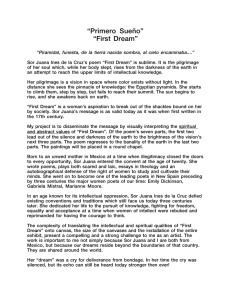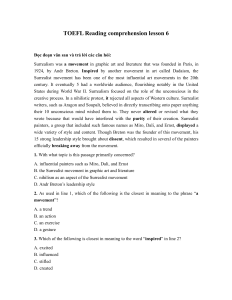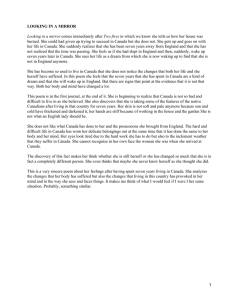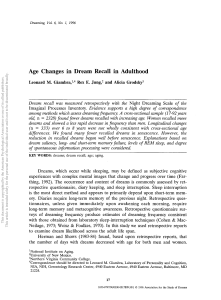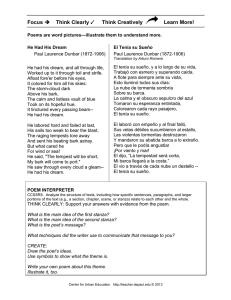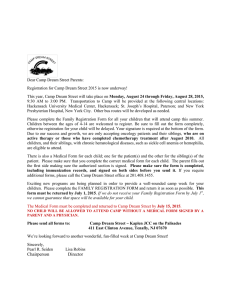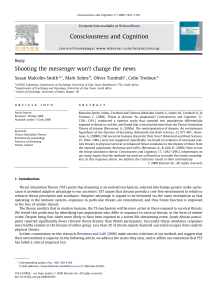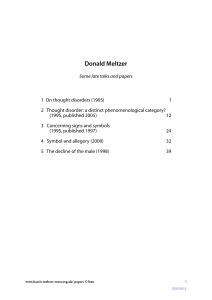SELECTION OF CATALOGUE TEXTS JOSÉ JIMÉNEZ “In the dream
Anuncio
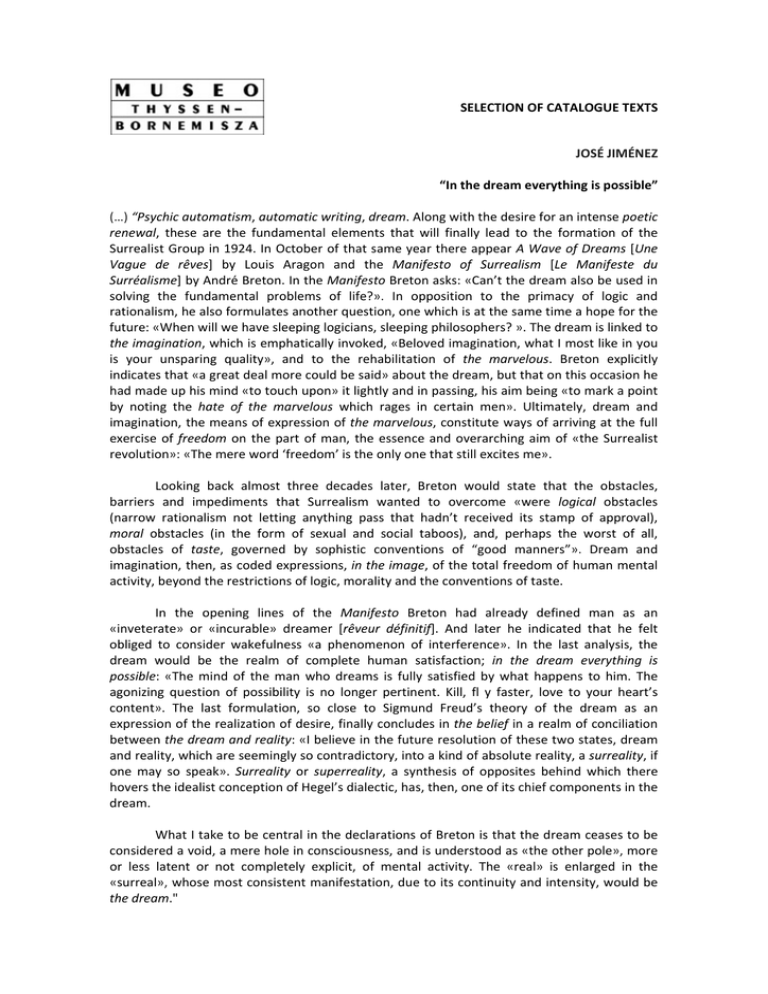
SELECTION OF CATALOGUE TEXTS JOSÉ JIMÉNEZ “In the dream everything is possible” (…) “Psychic automatism, automatic writing, dream. Along with the desire for an intense poetic renewal, these are the fundamental elements that will finally lead to the formation of the Surrealist Group in 1924. In October of that same year there appear A Wave of Dreams [Une Vague de rêves] by Louis Aragon and the Manifesto of Surrealism [Le Manifeste du Surréalisme] by André Breton. In the Manifesto Breton asks: «Can’t the dream also be used in solving the fundamental problems of life?». In opposition to the primacy of logic and rationalism, he also formulates another question, one which is at the same time a hope for the future: «When will we have sleeping logicians, sleeping philosophers? ». The dream is linked to the imagination, which is emphatically invoked, «Beloved imagination, what I most like in you is your unsparing quality», and to the rehabilitation of the marvelous. Breton explicitly indicates that «a great deal more could be said» about the dream, but that on this occasion he had made up his mind «to touch upon» it lightly and in passing, his aim being «to mark a point by noting the hate of the marvelous which rages in certain men». Ultimately, dream and imagination, the means of expression of the marvelous, constitute ways of arriving at the full exercise of freedom on the part of man, the essence and overarching aim of «the Surrealist revolution»: «The mere word ‘freedom’ is the only one that still excites me». Looking back almost three decades later, Breton would state that the obstacles, barriers and impediments that Surrealism wanted to overcome «were logical obstacles (narrow rationalism not letting anything pass that hadn’t received its stamp of approval), moral obstacles (in the form of sexual and social taboos), and, perhaps the worst of all, obstacles of taste, governed by sophistic conventions of “good manners”». Dream and imagination, then, as coded expressions, in the image, of the total freedom of human mental activity, beyond the restrictions of logic, morality and the conventions of taste. In the opening lines of the Manifesto Breton had already defined man as an «inveterate» or «incurable» dreamer [rêveur définitif]. And later he indicated that he felt obliged to consider wakefulness «a phenomenon of interference». In the last analysis, the dream would be the realm of complete human satisfaction; in the dream everything is possible: «The mind of the man who dreams is fully satisfied by what happens to him. The agonizing question of possibility is no longer pertinent. Kill, fl y faster, love to your heart’s content». The last formulation, so close to Sigmund Freud’s theory of the dream as an expression of the realization of desire, finally concludes in the belief in a realm of conciliation between the dream and reality: «I believe in the future resolution of these two states, dream and reality, which are seemingly so contradictory, into a kind of absolute reality, a surreality, if one may so speak». Surreality or superreality, a synthesis of opposites behind which there hovers the idealist conception of Hegel’s dialectic, has, then, one of its chief components in the dream. What I take to be central in the declarations of Breton is that the dream ceases to be considered a void, a mere hole in consciousness, and is understood as «the other pole», more or less latent or not completely explicit, of mental activity. The «real» is enlarged in the «surreal», whose most consistent manifestation, due to its continuity and intensity, would be the dream." GEORGE SEBBAG “What is Surrealism? A dream, a dream narrative, a film, an album of photos, a poem, a collage, a painting…” “The Surrealists packed a punch. They embarked on a reformation of understanding. Better yet, they carried out an «integral recasting of the human spirit» (Breton 1957). These new founders of «mental substance» (Aragon 1924) donned the mantle of the poet and the philosopher, refurbished the tools of the artist and the experimenter, and forged a group. They seized upon the dream, mental substance par excellence, and made it run the gauntlet. They tried and tested it from all angles: dream [rêve], erotic slumber [sommeil érotique], nightmare, somnambulism, mediumistic state, hypnotic sleep, hypnagogic visions (at the onset of sleep, during semi‐wakefulness or on awakening), waking dream, reverie, erotic reverie. They experienced and studied the dream [le rêve] on a sentient, aesthetic and theoretical level. Since they sought to conduct their own research, they were not burdened, at least to begin with, by the interpretation of dreams proposed by Sigmund Freud. For them, the choice of the dream was a major concern, as is clearly shown by the philosophical definition of Surrealism proposed by André Breton in 1924: «Surrealism is based on the belief in the superior reality of certain forms of previously neglected associations, in the omnipotence of the dream, and in the disinterested play of thought». (…) Definitive dreamers or sleeping logicians, the Surrealists go in quest of a philosophy of the dream and the image. By day as well as by night they hoist the colors of the imagination. The dream, connective tissue of images and of film shots, is the stronghold and perhaps even the source of the imagination. Aragon, Breton and their friends quickly understood that there were as many Surrealist images in their dream narratives as in their notebooks of automatic writing. The driving force of automatism transports and transforms images. Surrealist paintings are not fixed—they are simply in freeze‐frame. Following the example of the metaphysical pictures of de Chirico, they pulsate with life, condense an enigma and fix a moment of eternity. (…) Each artist animates a series of images in the trajectory of his or her dreams. Le Facteur Cheval trudges along untiringly in order to construct a lithochronic palace with staircase and niches. Amidst a virgin forest «Le Douanier» Rousseau plants a nymph on a divan and a woman snake charmer. De Chirico maps the metaphysical city of Turin in which the Mole Antonelliana rises to the height of «the purity of a dream». Selfhypnosis guaranteed: in Anemic Cinema [Anémic cinema] Duchamp uncoils contrepèteries, erotic metatheses, on spinning spirals. With his scissors, brushes, collages and frottages, Ernst makes «a locomotive arrive on canvas» and «projects before our eyes the most captivating film in the world» (Breton 1921). Joan Miró flies over different lands while setting decoys from his flying trapeze. In Masson, the volcanic eruption of automatism petrifies the final erotic spasm of the sleeping Gradiva. Another dream of stone: Yves Tanguy travels across interminable beaches where the remains of the palace of memory break the surface. Thanks to his key of dreams [songes], Magritte activates a revolving curtain in which words are constantly out of sync with images. Night having fallen, Toyen impregnates her canvas with a tightrope‐sleepwalker balancing on the tip of a cerise mule. Identified with Victor Hugo in Breton’s dreams, Victor Brauner dots his premonitory visions with cabbalistic signs. Paul Delvaux’s cloned naked woman exhibits steadfast indifference, whatever her position. In Remedios Varo, the shadow of a she‐ werewolf is seated in an armchair. Psychological morphologies and fl owing sperm dampen Matta’s bed‐sheets. A ballerina‐fish glides around Jindrich Styrsky’s aquarium of dreams. (…) To all the expressions and manifestations of Surrealism—collages, automatic texts, dream narratives, manifestoes, tracts, drawings, paintings, photos, objects, magazines, exhibitions— one could apply the same generating and driving principle, that of the animated images of the dream. Following the impetus of Grandville, the Surrealists devote themselves to the image and affirm the dynamic of the dream, the continuity of psychic life. Challenging logical thought, the order of the world and linear time, they surprise themselves when cutting up images, twisting words, sticking the bits back together. Playing at the cadavre exquis of desire and chance, they discover the automatism of writing, of painting and of duration [durée]. The artist who responds to the necessity of the animated painting of the dream and the free, disinterested play of thought will go by the name of Surrealist.” DAWN ADES «Dreams, dreams, dreams, with each step the domain of dreams expands. Dreams, dreams, dreams, at last the blue sun of dreams forces the steel‐eyed beasts back to their lairs…» (Aragon 1924). “Joan Miró’s Photo: This is the Color of my Dreams [Photo: Ceci est la couleur de mes rêves], 1925, is a strange work, barely even a painting. The conjunction of the apparently innocent, off‐hand but carefully lettered assertion “Photo: this is the color of my dreams” and the formless smudge of blue pigment on an otherwise bare canvas is enigmatic to the point of obscurity. Words dominate the picture, and although Miró frequently added inscriptions to his canvases of this period, which he called “poem‐paintings,” they rarely take over so completely. It is nothing if not a challenge to the concept of representation. Photography, painting, dreams and automatism all seem to be brought into question. Photo: This is the Color of my Dreams lacks the luscious washes of blue pigment that flood other paintings of the period. And yet it is still a remarkably satisfying picture rather than a conceptual work of art. It is also an original and humorous response to contemporary Surrealist debates about dreams and their role in what the Surrealists had begun to see as the problem of painting, especially of painting dreams. (…) Dreams were at the heart of Surrealism’s foundation in 1924; they were collected and recorded as récits de rêve, dream narratives, and like the notion of «pure psychic automatism», were presented by Breton in his first Manifesto under the authority of Freud. In this text Breton gives dreams equal weight if not equal billing with the notion of automatism, to which they are related. The dictionary definition of Surrealism introduces the question of thought [pensée], whose relationship to the dream is a key issue for the Surrealists: «Psychic automatism in its pure state, by which one proposes to express—verbally, by means of the written word, or in any other manner—the actual functioning of thought. Dictated by thought, in the absence of any control exercised by reason, exempt from any aesthetic or moral concern». It is only in the following Encyclopaedia definition that the dream is introduced: «Surrealism is based on the belief in the superior reality of certain forms of previously neglected associations, in the omnipotence of the dream, in the disinterested play of thought» (Breton 1924). (…) In October 1924, shortly after the publication of the first Manifesto, the Surrealists acquired their own space and opened the Bureau de recherches surréalistes in the ground floor of a building at 15, rue de Grenelle, rented by the father of Pierre Naville, one of the group. This was the center of their collective activities, and was known also as the Centrale; it was open to the public from 4.30 to 6.30 pm every day, staffed by a changing rota of two of the Surrealists, who would welcome visitors, encourage them to tell their dreams, and answer their questions. It was «a door open onto the unknown». A ledger (Cahier de la permanence) recorded the events, visits and comments by the changing pairs of Surrealists in charge, and is an invaluable source for the first months of the movement and the production of the first review, La Révolution surréaliste. (…) Everything, in the months following the publication of the first Manifesto, was open to experiment and investigation. The only sure project was the review La Révolution surréaliste. Breton commented critically to his colleagues on the current plans for the contents of the review in the Cahier on October 30, 1924. Too many Surrealist texts, he says, and not enough dreams: «No news flashes, no anonymous communications, no announcements, no lovely advertisements, no lucky finds, nothing that testifies to a real extra‐ literary life. The whole thing as we feared is artistic in character. Not enough dreams either». The content of the review threatened to be, just as they had feared, artistic and literary. What he hoped for was some real life, the hidden underworld of the unconscious that might manifest itself in the actual underworld of the street, news reports, faits divers, chance encounters—and more dreams. Plans for the third issue of La Révolution surréaliste were already being discussed in December 1924: it was to be devoted to the dream, and members were exhorted to carefully edit their dream narratives. Artaud asked everyone to «isolate and note down everything in their dreams that seems to belong to a system, the whole unconscious systematic of the dream». (…) In 1925 Miró began the series of paintings on a blue ground, so blue as «the color of my dreams» is also the color of his paintings—though he did not otherwise add words to his «blue» paintings, but blue seems to have a natural affinity with dreams: the «blue sun of dreams», as Aragon said. The writing [écriture] on the canvas in Photo is more carefully lettered than in any of the other «poem‐pictures», which has the paradoxical effect of on the one hand underlining their graphic nature and on the other the divorce between line/word and color. It is as though Miró is meditating on the Surrealist tendency to give the word primacy over the image. In A Wave of Dreams Aragon describes the «nature of the troubled mental states brought on by Surrealism, by physical fatigue, by narcotics, and the way these resembled dreams and mystical visions together with the semiology of mental illness» which «led us to evolve this proposition which, alone, can explain and link all these factors: the existence of a mental substance». Eventually, he says, «it gradually dawned on us that the mental substance described above was, in fact, vocabulary itself. There is no thought outside words: the whole Surrealist experience evidences this proposition …” (Aragon 1924).

